FORT MORGAN — Navy Cove Oysters spawned as a scientific question posed by one scientist to another in 2011. Now, the C-student who became a pioneer in oyster hatcheries because of a choice …
This item is available in full to subscribers.
Please log in to continue |
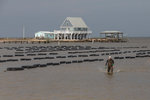
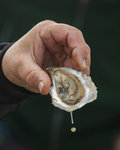
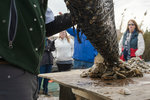
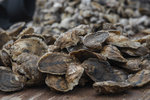
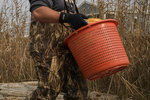



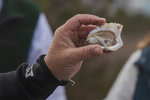


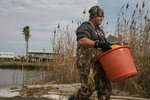


FORT MORGAN — Navy Cove Oysters spawned as a scientific question posed by one scientist to another in 2011. Now, the C-student who became a pioneer in oyster hatcheries because of a choice given by a nun and the lifelong shrimper run a full-fledged farm growing 1 million oysters on a tip of Baldwin County.
The road that brought Charles "Chuck" Wilson and John Supan, both marine science researchers, together is long and winding — and lined with gray and white shells rather than yellow bricks — but they hope telling it will help support local oyster habitat and industry.
Wilson grew up in Northern Baltimore County, Maryland, on a farm but spent time fishing and camping on the Chesapeake Bay with his family.
Once he was old enough to drive, he would rent a boat to catch crabs.
"We would fish from whatever beach we were at," Wilson said. "It was in my blood from a very young age until I was approaching middle high school and early college, and that enthusiasm never went away."
Wilson studied biology at Hampton Sydney College in Virginia. It was a college road trip to visit a friend in Hilton Head, South Carolina, that led him to the trailhead of his own, self-described yellow brick road.
"I went out on a shrimp boat one day, and it just became an enigma to me. From that point on, I wanted to be a shrimper. I never thought about a career. I just wanted to be a shrimper," Wilson said. "I finished college and put my dog in my hippie van, and we drove down to South Carolina."
Little did he know the experience he gleaned from working in shrimping and commercial fishing for a year and a half would be valuable to his next steps.
"It was an adventure, but I realized I needed to do something to grow up. It was a tough life," he said.
When he got engaged to his now-wife, Loula, her father asked if he wanted to be a shrimper for the rest of his life. He knew he needed to go back to school.
While knocking on doors at the University of South Carolina, he encountered a guy who asked if he could run a boat. Turns out he was a microbiologist who had a large project in South Carolina to study the movement of bacteria in and out of the estuary. Wilson was hired and ran a boat, collected data and did a thesis.
"It is all about opportunities that open up when you are walking down the yellow brick road. You decide on which way you turn, but you don't know where you are going to turn until you get to that intersection," he said.
Wilson solved swordfish age and growth and then worked on blue marlin in Hawaii and sailfish in Costa Rica, publishing several papers along the way. Then a job for fisheries development opened in Louisiana. He said he got the job because of his commercial background and scientific understanding. When he and his wife moved to Louisiana, he told her they would only be there for three years.
Three turned into 27.
"It was a great ride. I solved a lot of biological issues related to legislative decisions on how we manage fish. It turns out every fish we touched, they eventually restrained harvest on because regulations were not based on sound biological data," Wilson said. "We just went from fish to fish and were funded by many different sources to solve those questions: How old are they when they reproduce? How fast do they grow? How many babies do they put out, and how many babies survive?"
The last fish Wilson tackled was red snapper. He significantly contributed to the general understanding of the fish, and his learnings are still used to make decisions on harvest limits.
During his career, Wilson did a lot of administrative stuff and ran a large research program at LSU called Sea Grant. It was through the Sea Grant that he met John Supan.
Unlike Wilson, John Supan didn't grow up around saltwater.
Instead, he spent his youth exploring the fresh waters of the Ohio River and the streams and creeks that ran through his small town of Glen Dale, West Virginia.
Early on in his life, Supan said, he was into making a buck.
"I was a commercial fisherman at the age of 12. My granddaddy would pay me a quarter for every carp I caught in the Ohio River and buried in his garden for fertilizer," Supan said. "Then one day I caught hell from my mom because she found out I was using her clothesline to drag the fish up the alley."
Supan went to a small Catholic high school and lived in his straight-A sister's shadow. He was a C student who did well in subjects he enjoyed and not well in others until a chance encounter with the school counselor, Sister Barbara, set him on course for the future.
"It was senior week ... and Sister Barbara caught me in the hallway harassing the juniors," Supan said. "She called me into her office, and I thought I was going to catch hell for being in the hall when I shouldn't have been in school. She asked me what I was going to do with my life. I said I didn't know. She then asked, 'When you are having fun, what are you doing?'"
He didn't want to tell the nun the real answer, which was hanging out at the pool looking at girls in bikinis. Instead, he went with his second choice: hanging with the guys at the river shooting snakes and catching fish.
Sister Barbara grabbed a three-ring binder from a shelf, opened it up and handed it to Supan. One page said oceanography, and the other marine biology.
After reading about marine biology, Supan said he knew that is what he wanted to do.
At his high school graduation, Supan was surprised to receive a small scholarship to a local Jesuit college just 10 miles up the road in Wheeling, West Virginia. He struck a deal with his parents to work summers at the local steel mill and save to cover fall semester's tuition, book room and board if his parents would pay for the spring semester. He enrolled to study biology at Wheeling College (which became Wheeling Jesuit College and is now Wheeling University), intending to only be there a year before transferring to the University of Miami to enter their marine biology program.
Supan's plans changed when he met Betty Thacker, the biology chair. She had received her Ph.D. in marine biology from the University of Delaware. Her advice to Supan was to stay put to get his basics and specialize in graduate school. At the time, he didn't know what graduate school was.
"She became a very friendly mentor for me," Supan said. "She helped me tailor the program to marine biology. Every class you had to do a research topic, and while my friends were feeding zinc pellets to rats and measuring how much comes out in their feces, she taught me to wade the local streams and use the same techniques in fresh water to apply to salt water."
After graduating, Supan hung around Wheeling for a few years, worked as a bartender and met his wife, Karen. They married and three days later moved 1,000 miles to Biloxi, Mississippi. He started on a master's degree at the University of Southern Mississippi in 1978. His path started to fork toward oysters.
"A guy named Ed Cake took me on as a graduate student. He had just got a big Food and Drug Administration grant to look at purifying polluted oysters called depuration," Supan said. "I got on as a student worker and grad student on that project, and that is when I got exposed to oysters at an industrial scale because part of my project was to help a local company."
The professor had two concepts for cleansing the oysters from the polluted Biloxi Bay, but only one received funding. He was assigned to work with Gollotts Seafood on the second concept called relaying.
"Rather than my boss's project, which was to take oysters, put them in baskets and put them in tanks of flowing seawater with all the capabilities recirculating it and ultraviolet light to kill the bacteria," Supan explained, "the other concept was simply to put them in containers and take them offshore in clean water, and pick them up 14 days later as required by law. It is called relaying."
Instead of the past relaying method of dredging or scraping the oysters up, dumping them overboard on a bottom-water lease and then dredging them up 14 days later, Supan worked on container relaying with the Gallotts. They put the harvested oysters in trays and set them out in clean water for 14 days. The trays made them easier to harvest.
The conclusion of the two concepts was that container relaying was more economically feasible.
The assistantship taught Supan to handle a boat and sparked his love of sailing.
He received his master's in 1981 and spent three more years at the lab working in fisheries assessment monitoring. That position exposed him to all the commercial fishermen and sparked his love of being the "gear guy." He was responsible for taking care of all the sampling gear: beam trawls, plankton nets, shrimp trawls and rods and reels.
He reached the top of the ladder at the lab in three years, so he started looking for his next step.
That next step is where he and Wilson's paths crossed.
The same funding that created Wilson's job in Louisiana created a fisheries Extension agent position in Saint Tammy Parish, Louisiana. For the next six years, Supan worked as an Extension agent.
"My job was a teacher. The county agent goes around and teaches but more importantly, you listen and do a needs assessment. Your role is to listen to the needs of your community and go back to the university and have them address those needs. It is the link from the university and the field and back," Supan said.
Wilson became important to Supan and the other Extension agents because they were trying to help local shrimpers who found out they could take off the shrimp gear and put long lines on and catch tilefish and swordfish.
"None of us knew a damn thing about it," Supan said. "We were hunting down Chuck because he was our specialist when it came to offshore. For me to be able to help a shrimper who has decided to go offshore and catch tile fish, I had to find someone. That is how we first started working together."
Because oysters are bound to the spot where they settle, they are at the mercy of the water that flows through. Water that is too fresh kills them. Water that is too high in salinity welcomes animals like snails and crabs that like to snack on the mollusks. A snail called the oyster drill can kill 85% of young oysters on a reef, according to the Alabama Cooperative Extension System.
When Supan was working shucking houses on the Mississippi River in the late 1980s, there was no annual flood in the spring for several years in a row.
Saltwater intruded into the estuaries.
"There weren't any oysters to be had in Louisiana. Sack prices that were $8 a sack, which is a bushel and a half, went up to $30 a sack in three years from 1987-1989," he said. "There were no oysters to shuck, and I had some major shucking houses in my beat. A couple of guys found out they could go up to the Pacific Northwest where their meats were plentiful because they didn't depend on the wild seed up there."
They depended on hatchery-produced seed.
Supan knew about hatcheries from his time in Biloxi. They were technically successful but an economic failure on the Gulf Coast because there were so many wild oysters around that they couldn't compete.
A trip to Oregon with two of his clients would change his path yet again and introduce him to his mentor, Lee Hanson.
"I like to tell the story Moses knew about God, but when he saw the burning bush he came back a changed man," Supan said. "When I went to Oregon and saw Whiskey Creek Shellfish Hatchery, that was my burning bush. We came back and my two clients wanted to start an oyster hatchery. The first commercial one on the Gulf of Mexico. This was in 1990."
The three sat down with the Sea Grant director. He helped them tell their story and about the Pacific Northwest. The Sea Grant got on board, partnered with Supan's clients and created a position for him. His new job was to teach people how to use hatchery technology in Louisiana
"The idea behind the Gulf Shellfish Farm (in Grand Isle, Louisiana) was to spawn oysters, mix the eggs and sperm and over 12 days in the hatchery, you feed them cultured algae and then they are swimming larvae. You look at them under a microscope and you know when they are ready to cement onto something. You can gather them up and put them in a wet coffee filter and ship them anywhere. You pour them into a tank of clean oyster shells, and they are spat. Make your own seed. It's called remote setting, spat on culch. That was the project," Supan said.
Supan worked to teach the local oyster farmers to spat their own shells before they put the empty shells back in the water. Two years after starting the hatchery, the area received a historic rainfall in 1992. By 1993, the wild oyster population returned. By 1994, his two clients didn't want their own hatchery anymore.
Supan had a new problem to solve.
If a hatchery was going to succeed anywhere with wild oyster production, it had to produce something Mother Nature can't. As a doctoral candidate, he needed to write a research proposal to get grant money.
His proposal was on how triploid oysters could be used in Louisiana to increase meat yields.
"In the wild, an oyster gets fat in the winter because of the cold water. If you shuck a bushel and a half of oysters in the winter, you will get 12 pints of meat. They are selling gallons to restaurants that only hold 8 pints of meat so there was a 4-pint profit," Supan explained. "Spring comes in late April or early May and as water temperatures rise, the oysters just naturally spawn in the environment, and they burn that winter fat. By the time they are done spawning two months later, they are skinny and watery. Meat yields drop from 12 pints to 4 pints, so now it takes two sacks of oysters to make a gallon and they are losing money in the summertime."
What is a triploid oyster?
"You and I and the birds and the bees, we are all diploids. We have a set of chromosomes from our mother (maternal) and a set from our father (paternal)," Supan said. "A triploid has three sets, and you create that through a breeding process in a hatchery. What that does is it makes the oyster sexually sterile; it cannot reproduce. It gets fat in the winter as all oysters do, but it stays fat in the summer."
During Supan's research, one name kept coming up: Standish Allen Jr. He was doing university research on triploids and asked to collaborate rather than peer review Supan's proposal.
"That was the beginning of the triploid saga," Supan said. "That was the commercialization of the triploid oysters. Everyone that has grown oysters in cages has pretty much grown triploids."
Supan became the first person to stud out oysters in the Gulf of Mexico. He would strip sperm out of a male tetraploid (which has four sets of chromosomes), put it in a little vial in ice water and drive eight hours to an oyster hatchery in Florida. He would teach them to spawn their females separate from the males, get a bucket full of eggs and pour the sperm in to make triploids.
"They called me the oyster stud for a while," Supan said. "That is how we disseminated that technology to the industry."
"I ran a breeding program for oysters from 1993 to when I retired in 2017. The idea was to establish triploid oysters for the Gulf region, and it was a huge success. That is my legacy from my career at LSU."
Over the years as colleagues, Wilson and Supan became close friends and spent time at Wilson's Fort Morgan beach house. In 2011, while their wives were on the beach, the two men were enjoying the views over Navy Cove when Wilson asked Supan a question that would trigger their future endeavors.
"Do you think we could farm oysters there?" he wondered
They put their wading shoes on and headed across the road.
Navy Cove's hard sandy bottom, waist-deep water and location two miles from the Gulf where all the saltwater was coming from made it a good site. The fact that every house on that cove was on city water instead of a septic tank made it perfect.
"We threw 10 cages in the water for a couple of years and had fun eating them all," Supan said. "Then we got serious about it."
Wilson had retired and moved to Fairhope, but they got serious once Supan retired and started coming every week.
"We didn't feel like sitting on the beach drinking what the girls were drinking," Supan said, jokingly.
"I have always had an entrepreneurial spirit, starting a shrimp farm, so I understood aquaculture," Wilson responded on a more serious note. "I knew we could raise oysters; it was pretty obvious we had the technology and knowledge and willingness to do it. And it was obvious we had a market because oyster production in Mobile Bay has dropped off to a fraction of what it was 50 years ago because of all the environmental noise. It struck me that this might be a good business venture."
The first question was whether oysters would grow at a rate that would be business feasible. Wilson said they grew like banshees. Even better, they were great and salty.
The farm slowly started to grow on the 2 acres they secured in Navy Cove. Wilson took on the role of managing partner and handles all the details, paperwork and communications. Supan settled into the role of overseeing technology and makes sure their farming practices are sound.
In 2016, they brought on a third partner. Eric Bradley's experience working in the restaurant industry at Sassy Bass was important, but he also knew social media. Bradley also grew up on a crawfish farm and was familiar with aquaculture. He is now the full-time farm manager.
They sold 345,000 oysters in 2022 and now have 1 million oysters in the water. It is no longer a part-time job.
A FULLY FORMED CULTCH
Navy Cove Oysters can be found in restaurants in Georgia, Texas, Louisiana and Alabama. They have a moderate brine, rich, creamy, buttery texture and a sweet cucumber-like finish.
"We call ourselves a for-profit research farm. We invite people who want to do research. This is grant cycle time, and I have gotten three requests in the last month from people asking us to be a collaborator," Wilson said. "We have a research program right now by graduate students from Auburn that they started two years ago."
Another unique aspect of the farm is they offer tours throughout the year by appointment. The career educators enjoy teaching visitors of all ages about the ecology and geology of Mobile Bay and how they raise oysters using sustainable aquaculture techniques. When the weather is warm enough, visitors wade out to the floating cages and see the process up close.
Wilson and Supan are also advocates and want to see more oyster farms on the Fort Morgan peninsula. After all, it's about more than their own survival. The more oysters we have in the Gulf Coast waters, the cleaner the water will be for us all.